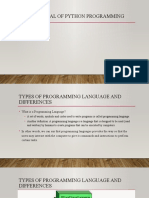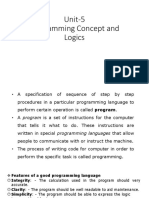0% found this document useful (0 votes)
42 views3 pagesProgramming Languages
This document discusses different types of programming languages. It describes low-level languages like machine language and assembly language which are closer to machine code. It also describes high-level languages like BASIC, COBOL and Pascal which use English-like syntax. High-level languages are easier for humans to read and write but require translation before execution. The document contrasts the advantages and disadvantages of both low-level and high-level languages.
Uploaded by
Taonaishe Hastings MuzavaziCopyright
© © All Rights Reserved
We take content rights seriously. If you suspect this is your content, claim it here.
Available Formats
Download as PDF, TXT or read online on Scribd
0% found this document useful (0 votes)
42 views3 pagesProgramming Languages
This document discusses different types of programming languages. It describes low-level languages like machine language and assembly language which are closer to machine code. It also describes high-level languages like BASIC, COBOL and Pascal which use English-like syntax. High-level languages are easier for humans to read and write but require translation before execution. The document contrasts the advantages and disadvantages of both low-level and high-level languages.
Uploaded by
Taonaishe Hastings MuzavaziCopyright
© © All Rights Reserved
We take content rights seriously. If you suspect this is your content, claim it here.
Available Formats
Download as PDF, TXT or read online on Scribd
/ 3

















































































































